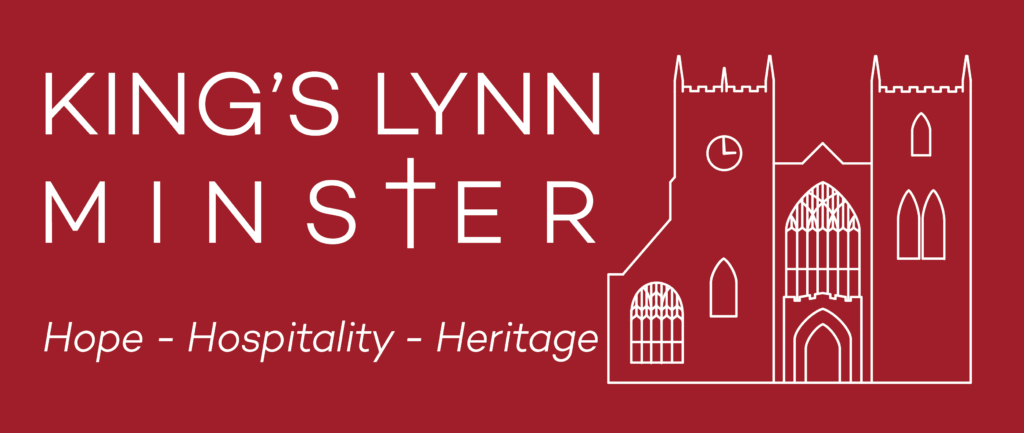Margery Kempe was a medieval mystic and pilgrim born in Bishop’s Lynn in 1373. The church of St Margaret, St Mary Magdalene and All the Virgin Saints (today known as King’s Lynn Minster) was her parish church. Here, Margery spent many hours in prayer and contemplation.
Margery came from a wealthy and influential family of merchants. Her father was John Brunham, five times mayor of Lynn, MP, and alderman of the Holy Trinity Guild. She married John Kempe, a burgess of Lynn, in 1393. Their marriage produced 14 children although it is unclear how many of them survived into adulthood. As a medieval woman from Bishop’s Lynn, Margery was accustomed to a life of wealth as evident from her fashionable outfits with gold pipes in her hair, and slit dresses displaying colourful and expensive fabrics. To supplement her household income, she set up a brewing business and took to milling, but all her ventures eventually failed.
Margery’s first pregnancy resulted in a difficult birth and an episode of mental distress which many modern scholars have diagnosed as postpartum psychosis. She was plagued by terrifying visions of demons and had to be restrained in her bedchamber so as to not cause harm to herself and others. The torments were all lifted when she saw a vision of Christ at her bedside, who spoke to her “Daughter, why have you forsaken me, and I never forsook you?”

This vision and the ones that followed caused a shift in Margery’s life. She desired to dedicate her life to Christ and spent many hours at prayer in St Margaret’s Church. She wore a hairshirt underneath her clothes and fasted on bread and water. She also desired chastity and pleaded with her husband that they should take a vow of chastity together. One of the key manifestations of Margery’s faith were her uncontrollable bouts of weeping.
Margery was moved to visit holy shrines so that she could understand God’s message better. Her early pilgrimages were undertaken in the company of her husband. She travelled to shrines across England, often seeking validation for her visions and experiences. She visited Julian of Norwich in 1413 to seek her guidance and reassurance. Julian confirmed that Margery’s visions came from God and that her tears are physical evidence of the Holy Spirit in her soul.
Whilst she was generally welcomed on her travels abroad, in England she found many were against her. But it was in her home town of Lynn that Margery found the most opposition and criticism. During her travels across the country, she was accused of heresy on multiple occasions. All the evidence suggests that she was in fact faithful to the belief of the Church. Her prosecution, however, could have been a hook on which to hang other fears and objections to Margery. Whilst Margery challenges Bishops, and ecclesiastical authorities, they supported and encouraged her more than the ordinary people.
The Book of Margery Kempe
The Book of Margery Kempe, is known as the first spiritual autobiography in English.
Margery claims she was illiterate and ‘not lettryd’, so she dictated her book to scribes. It is not a chronological account of her life, but a fascinating dialogue between Margery and visions of God, Christ and the saints about faith and the meaning of a good Christian life.
The Book ignores anything that is not primarily the story of Margery’s relationship with God and her spiritual journey. The purpose of her work is to reveal and authorise the meaning and truth she believes God had called her to follow.
The Book is divided into two parts. The first part in many ways follows the format of similar devotional texts of the period, particularly those by women mystics and visionaries. Through various experiences, childbirth, madness and her first vision of Christ, Margery narrates her spiritual journey which leads to her travels, and the ’gift of tears’. Margery recalls accusations of Lollardy made against her, as well as her travels to the Holy Land, Assisi, Rome and Santiago. She also details two great fires in Lynn.
The second part resembles a travel journal, or memoir. It features the death of Margery’s husband, John Kempe, as well as her son. Margery accompanies her daughter-in law back to Prussia and travels on to Danzig and Aachen, finally returning to Syon Abbey.
It is clear from her Book that Margery not only has an extremely retentive memory, but that she is very familiar with other books of devotion and spirituality, the Liturgy of the Church, as well as the Bible.
